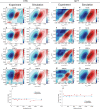Water inside the Selectivity Filter of a K+ Ion Channel: Structural Heterogeneity, Picosecond Dynamics, and Hydrogen Bonding
- PMID: 38181505
- PMCID: PMC10797622
- DOI: 10.1021/jacs.3c11513
Water inside the Selectivity Filter of a K+ Ion Channel: Structural Heterogeneity, Picosecond Dynamics, and Hydrogen Bonding
Abstract
Water inside biological ion channels regulates the key properties of these proteins, such as selectivity, ion conductance, and gating. In this article, we measure the picosecond spectral diffusion of amide I vibrations of an isotope-labeled KcsA potassium channel using two-dimensional infrared (2D IR) spectroscopy. By combining waiting time (100-2000 fs) 2D IR measurements of the KcsA channel including 13C18O isotope-labeled Val76 and Gly77 residues with molecular dynamics simulations, we elucidated the site-specific dynamics of water and K+ ions inside the selectivity filter of KcsA. We observe inhomogeneous 2D line shapes with extremely slow spectral diffusion. Our simulations quantitatively reproduce the experiments and show that water is the only component with any appreciable dynamics, whereas K+ ions and the protein are essentially static on a picosecond timescale. By analyzing simulated and experimental vibrational frequencies, we find that water in the selectivity filter can be oriented to form hydrogen bonds with adjacent or nonadjacent carbonyl groups with the reorientation timescales being three times slower and comparable to that of water molecules in liquid, respectively. Water molecules can reside in the cavity sufficiently far from carbonyls and behave essentially like "free" gas-phase-like water with fast reorientation times. Remarkably, no interconversion between these configurations was observed on a picosecond timescale. These dynamics are in stark contrast with liquid water, which remains highly dynamic even in the presence of ions at high concentrations.
Conflict of interest statement
The authors declare the following competing financial interest(s): M.T.Z. is a co-owner of PhaseTech Spectroscopy, which sells ultrafast pulse shapers and multidimensional spectrometers.
Figures




Update of
-
Water inside the selectivity filter of a K+ ion channel: structural heterogeneity, picosecond dynamics, and hydrogen-bonding.bioRxiv [Preprint]. 2023 Nov 17:2023.11.16.567415. doi: 10.1101/2023.11.16.567415. bioRxiv. 2023. Update in: J Am Chem Soc. 2024 Jan 17;146(2):1543-1553. doi: 10.1021/jacs.3c11513. PMID: 38014355 Free PMC article. Updated. Preprint.
Similar articles
-
Water inside the selectivity filter of a K+ ion channel: structural heterogeneity, picosecond dynamics, and hydrogen-bonding.bioRxiv [Preprint]. 2023 Nov 17:2023.11.16.567415. doi: 10.1101/2023.11.16.567415. bioRxiv. 2023. Update in: J Am Chem Soc. 2024 Jan 17;146(2):1543-1553. doi: 10.1021/jacs.3c11513. PMID: 38014355 Free PMC article. Updated. Preprint.
-
Probing Ion Configurations in the KcsA Selectivity Filter with Single-Isotope Labels and 2D IR Spectroscopy.J Am Chem Soc. 2023 Aug 23;145(33):18529-18537. doi: 10.1021/jacs.3c05339. Epub 2023 Aug 14. J Am Chem Soc. 2023. PMID: 37578394 Free PMC article.
-
Instantaneous ion configurations in the K+ ion channel selectivity filter revealed by 2D IR spectroscopy.Science. 2016 Sep 2;353(6303):1040-1044. doi: 10.1126/science.aag1447. Science. 2016. PMID: 27701114 Free PMC article.
-
Two-dimensional infrared spectroscopy of intermolecular hydrogen bonds in the condensed phase.Acc Chem Res. 2009 Sep 15;42(9):1220-8. doi: 10.1021/ar900006u. Acc Chem Res. 2009. PMID: 19425543 Review.
-
Ion-protein interactions of a potassium ion channel studied by attenuated total reflection Fourier transform infrared spectroscopy.Biophys Rev. 2018 Apr;10(2):235-239. doi: 10.1007/s12551-017-0337-8. Epub 2017 Nov 22. Biophys Rev. 2018. PMID: 29168118 Free PMC article. Review.
Cited by
-
Unraveling dynamic protein structures by two-dimensional infrared spectra with a pretrained machine learning model.Proc Natl Acad Sci U S A. 2024 Jul 2;121(27):e2409257121. doi: 10.1073/pnas.2409257121. Epub 2024 Jun 25. Proc Natl Acad Sci U S A. 2024. PMID: 38917009 Free PMC article.
-
Modeling Infrared Spectroscopy of Nucleic Acids: Integrating Vibrational Non-Condon Effects with Machine Learning Schemes.J Chem Theory Comput. 2024 Nov 26;20(22):10080-10094. doi: 10.1021/acs.jctc.4c01130. Epub 2024 Nov 11. J Chem Theory Comput. 2024. PMID: 39526974
-
Hydrates of N-((10-Chloroanthracen-9-yl)methyl)-3-(1H-imidazol-1-yl)propan-1-ammonium Cobalt(II), Copper(II), and Zinc(II) 2,6-Pyridinedicarboxylate: Reversible Crystallization.ACS Omega. 2024 Nov 19;9(48):47848-47856. doi: 10.1021/acsomega.4c08822. eCollection 2024 Dec 3. ACS Omega. 2024. PMID: 39651092 Free PMC article.
-
Electronic Polarization Leads to a Drier Dewetted State for Hydrophobic Gating in the Big Potassium Channel.J Phys Chem Lett. 2024 Jul 25;15(29):7436-7441. doi: 10.1021/acs.jpclett.4c01359. Epub 2024 Jul 15. J Phys Chem Lett. 2024. PMID: 39008088 Free PMC article.
-
Multi-mode water dynamics in hydration shells of villin headpiece subdomain protein in the solid state using deuterium and oxygen-17 NMR spectroscopy.J Chem Phys. 2025 Jul 14;163(2):025101. doi: 10.1063/5.0279081. J Chem Phys. 2025. PMID: 40642973
References
Grants and funding
LinkOut - more resources
Full Text Sources

